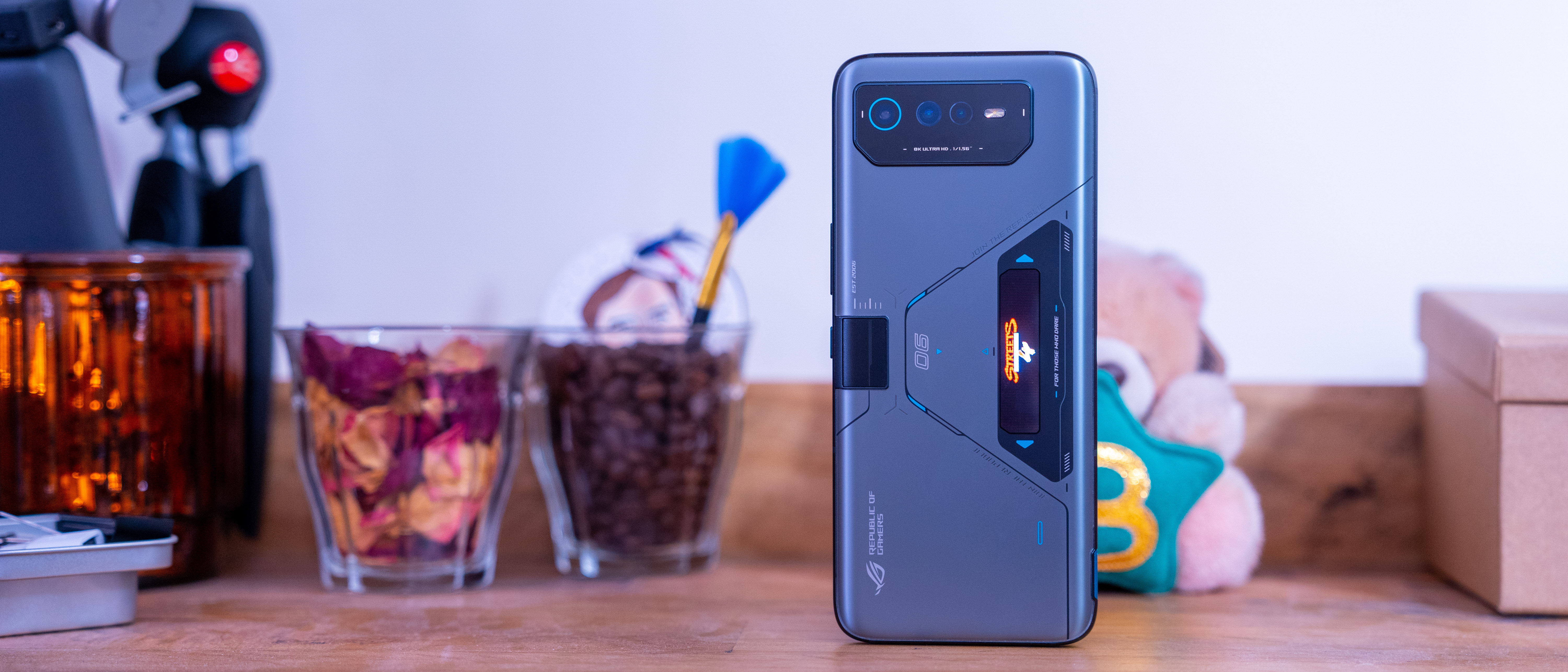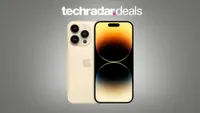TechRadar Verdict
Asus and MediaTek have proven that flagship gaming phone power isn't a one-horse, Qualcomm race with the ROG Phone 6D Ultimate. A reimagining of the excellent 6 and 6 Pro and launching alongside both. With a new heat dissipation system, the phone games cooler than anything we've tested. Also packing excellent speakers, a mighty screen, and a fun, gaming-optimized UI. While the camera isn't going to blow you away, for a gaming phone, the 6D hits its mark.
Pros
- +
Best-in-class heat management
- +
Smooth, punchy, expansive screen
- +
Loud speakers with customizable tuning
- +
Gamer-centric UI is a lot of fun
Cons
- -
Camera performance could be better
- -
Pricier than iPhone 14 Pro
- -
Not available in the US
- -
No wireless charging
Why you can trust TechRadar
Two-minute review
If you thought Asus was done launching flagship gaming phones in 2022 after the excellent ROG Phone 6 was announced just two months ago – think again. The ROG Phone 6D and 6D Ultimate supplement the current line with MediaTek power, a mechanical air vent, and even a Batman Edition.
Very similar to the 6 and 6 Ultimate, the 6D series features a virtually identical design, except for the fact it now ships in a gunmetal grey. In its Ultimate edition,
the 6D also sports a flap around the back that raises when you hook up the AeroActive Cooler fan for improved airflow and heat management.
Advanced cooling may only be reserved for the Ultimate edition, but both the ROG Phone 6D and 6D Ultimate get a color screen around the back and are powered by MediaTek's new Dimensity 9000 Plus chipset.
The first time we've seen a mainstream smartphone maker pick MediaTek for a flagship experience in the West, the Dimensity 9000 Plus has big shoes to fill. After all, the ROG Phone 6 introduced the Snapdragon 8 Plus Gen 1 to the market – now the gold standard for Android performance.
Thankfully, in our time with the ROG Phone 6D Ultimate, MediaTek's chip performed incredibly well. And that winning impression was helped along by the phone's huge 6,000mAh battery and ample 512GB storage.
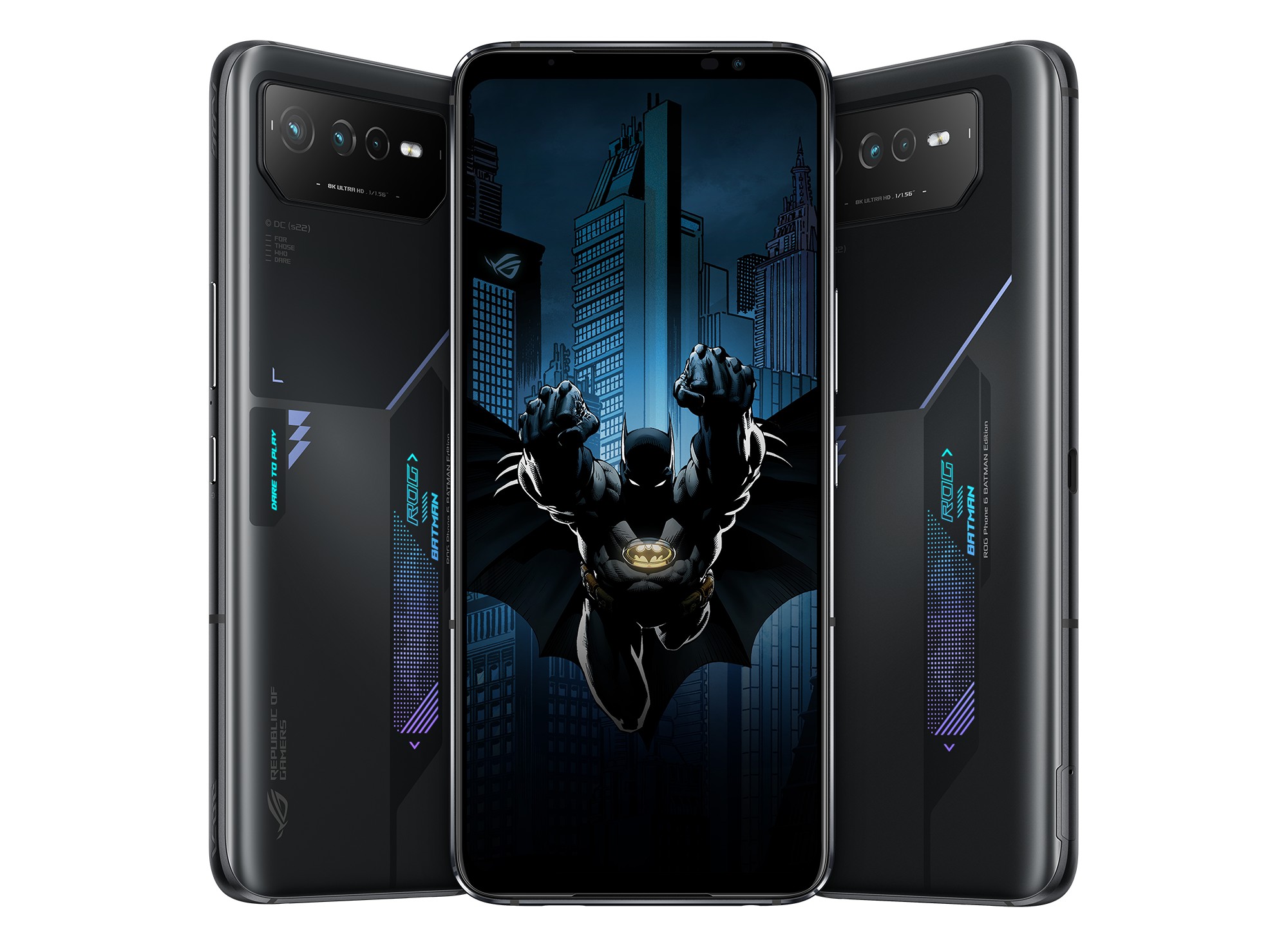
The ROG Phone 6D series has the same camera whether you get the vanilla version or the Ultimate, and it's the same camera mix introduced in the ROG Phone 6. That means it's good enough, but isn't best-in-class, especially in the Ultimate, which costs £1,199 (roughly $1,370 / AU$2,040).
The phone also misses out on wireless charging and has a relatively low-resolution Full HD+ screen. That said, those last two omissions make sense on a gaming phone. After all – wireless charging crams the chassis with more elements, which isn't great for heat management, and games are output in 1080p for Android, so the resolution is actually well-optimized for gamers.
Sign up for breaking news, reviews, opinion, top tech deals, and more.
And so, just as the ROG Phone 6 was the best gaming phone we'd tested, the ROG Phone 6D and 6D Ultimate are more of the same, with the 6D being a bit more affordable, and the 6D Ultimate being a bit pricier (and cooler).
Asus ROG Phone 6D Ultimate price and release date
- 6D and 6D Ultimate won't launch in US
- Entry-level 6D available in UK from £799
- 6D Ultimate available in UK from £1,199 w/ AeroActive cooler
The Asus ROG Phone 6D won't be available in the US, though has been confirmed for the UK and other regions. Pricing undercuts the original ROG Phone 6 in its base capacity. While the ROG Phone 6 launched at £899 (roughly $1,023 / AU$1,530) for the standard version with 256GB storage and 12GB RAM, the 6D costs £799 (roughly $910 / AU$1,360).
In its most premium, ROG Phone 6D Ultimate guise, however, you can expect to pay £1,199 (roughly $1,370 / AU$2,040), which is £100 more than the 6 Pro. It's the first time we can recall seeing a MediaTek version of a smartphone cost more than the Qualcomm option. That said, the price difference is more likely down to the 6D Ultimate's advanced cooling system, as opposed to the choice of chipset.
As for availability, pre-orders are open right now, and the phone will hit shelves at the end of October 2022.

This is the same pricing structure we've seen from Asus's ROG Phone line before – charging more than much of the gaming phone competition but delivering a superior user experience. The Red Magic 7s Pro starts at £669, in contrast, and is a fine option for anyone who doesn't mind a few rough edges. That said, Asus offers a much more refined software experience and a superior accessory suite.
- Value score: 4/5
Asus ROG Phone 6D Ultimate design
- Available in Space Grey
- New AeroActive Portal for advanced cooling
- Heavier than ROG Phone 6 Pro at 247g
While we wouldn't go so far as to call the ROG Phone 6D understated, for a gaming phone, there's something quite restrained about its design. Sporting the same general shape and styling as the rest of the 6-series, it features a smooth, pearlesque, frosted glass back, and rounded metal sides.
Unlike the ROG Phone 6, which was available in black or white, the 6D can be picked up in Space Grey, which is sort of a gunmetal grey, and it looks rich – a touch less standout than the white 6 Pro we reviewed.
Measuring 173 x 77 x 10.3mm, the phone's is a tall, relatively narrow thing that's thicker than most smartphones, but doesn't quite feel unwieldy. At 247g, it's heavier than the 237g ROG Phone 6. For context, the iPhone 13 Pro Max and 14 Pro Max weigh 240g.
The curvy, frosty back and matte sides do make the ROG Phone 6D feel rich and alluring, but it is pretty slippery, so you'll want to put a case on as soon as you start using it. Luckily, in the box, you get a lightweight, hard plastic shell that protects the corners, adds a little extra grip, and works with the cooling fan.
The ROG Phone's screen is protected by Gorilla Glass Victus, and while the phone doesn't sport IP68 water or dust resistance, it's IPX4 splash-resistant, even when the AeroActive Portal is open.
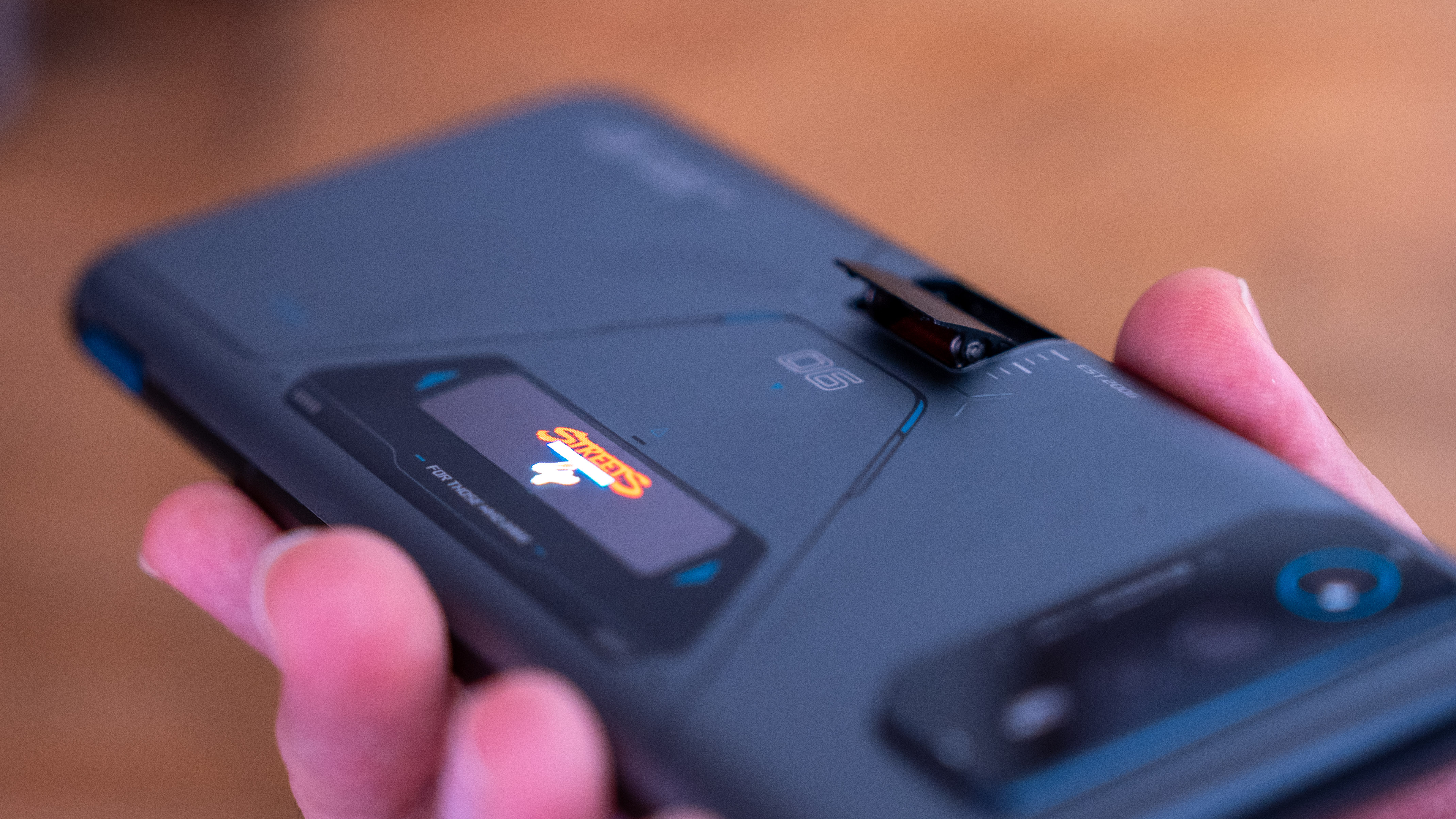

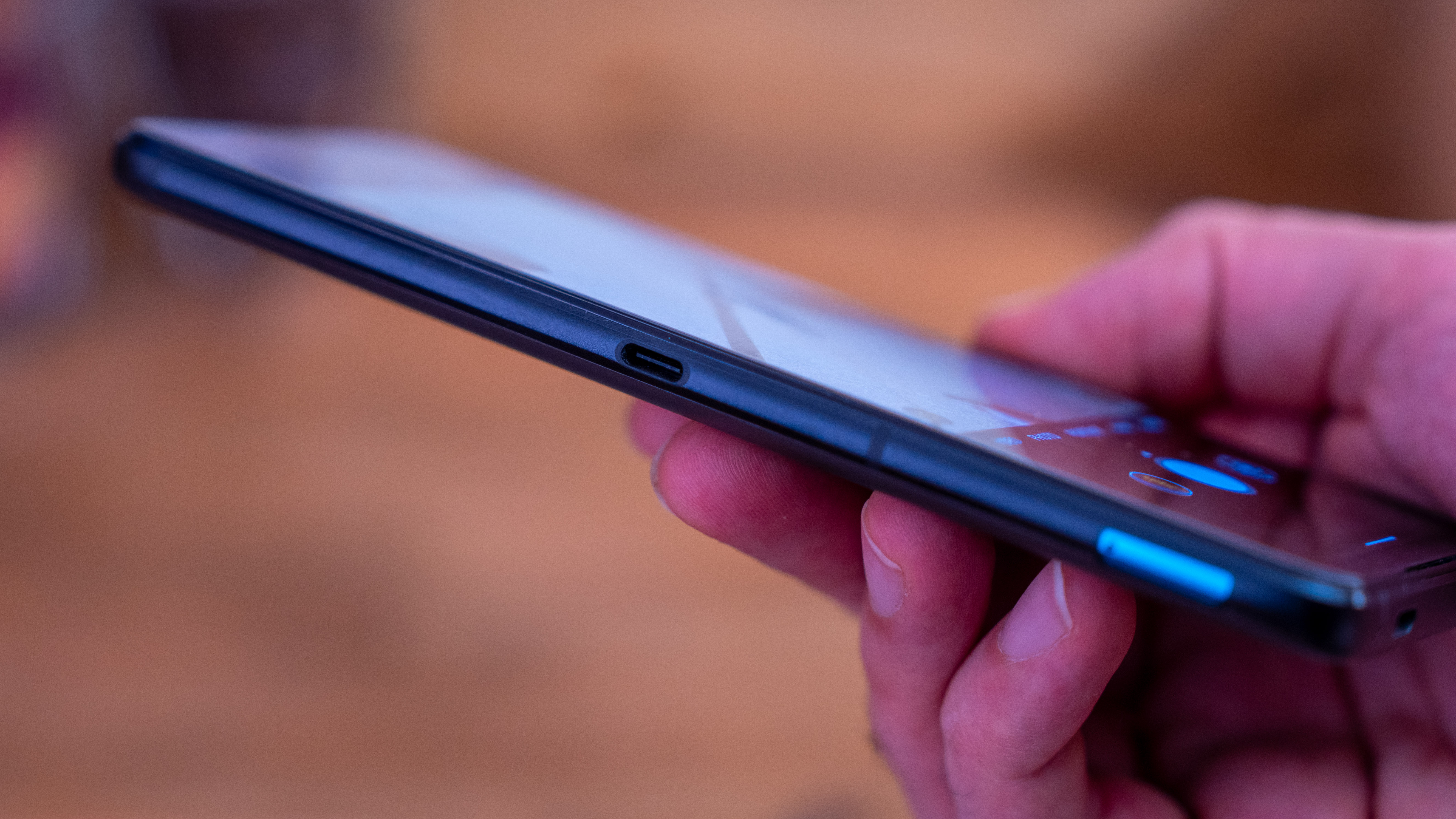
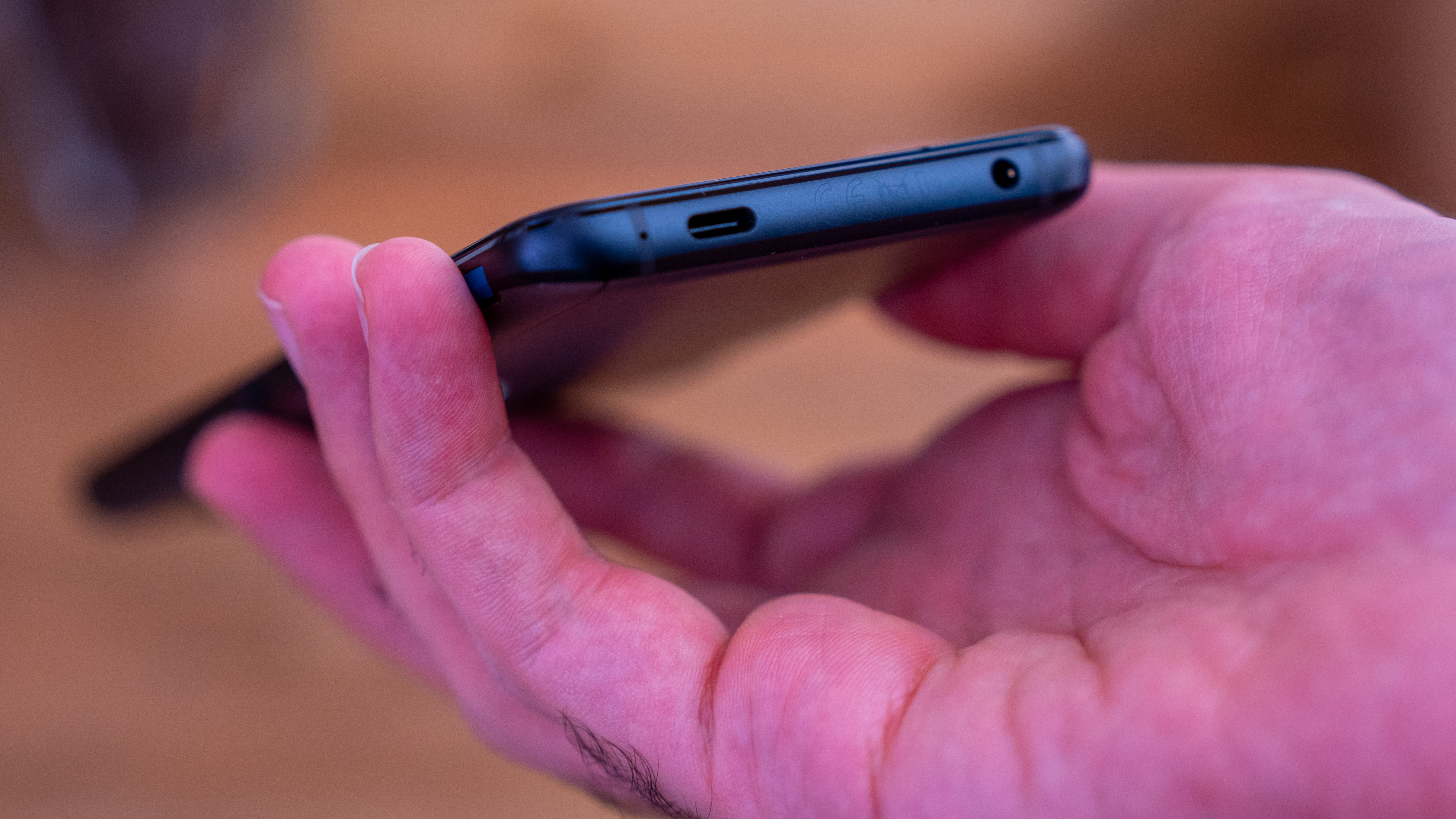
A flap on the back of the phone that mechanically rises when the fan's attached, the AeroActive Portal is inspired by the design of ROG gaming laptops. It features heat dissipation fins under the flap, and the other end of the vapor chamber is connected to the CPU.
When the flap is open and the AeroActive Cooler fan is connected to the 6D Ultimate, Asus claims nearly one liter of cold air is blown into the fins per second, and by way of air ducts, directly cools the CPU and dissipates heat. Very cool stuff, and the flap even uses technology Asus developed for its Asus Zenfone series, with its flip-out camera.
Dotted around the curved metal frame of the ROG Phone 6D are more ports than we're used to seeing. In addition to the 3.5mm headphone jack, there's a second USB port on the side of the phone. This is for accessories – like the dock and fan – but it also makes for a comfortable charging option when gaming in landscape orientation.
Asus doesn't install a pre-fitted screen protector on the ROG Phone 6D Ultimate, but does offer up an official option as a separate purchase. We had no issues with the in-display fingerprint scanner, and also set the phone's face unlock up to ensure we could get into it quickly.
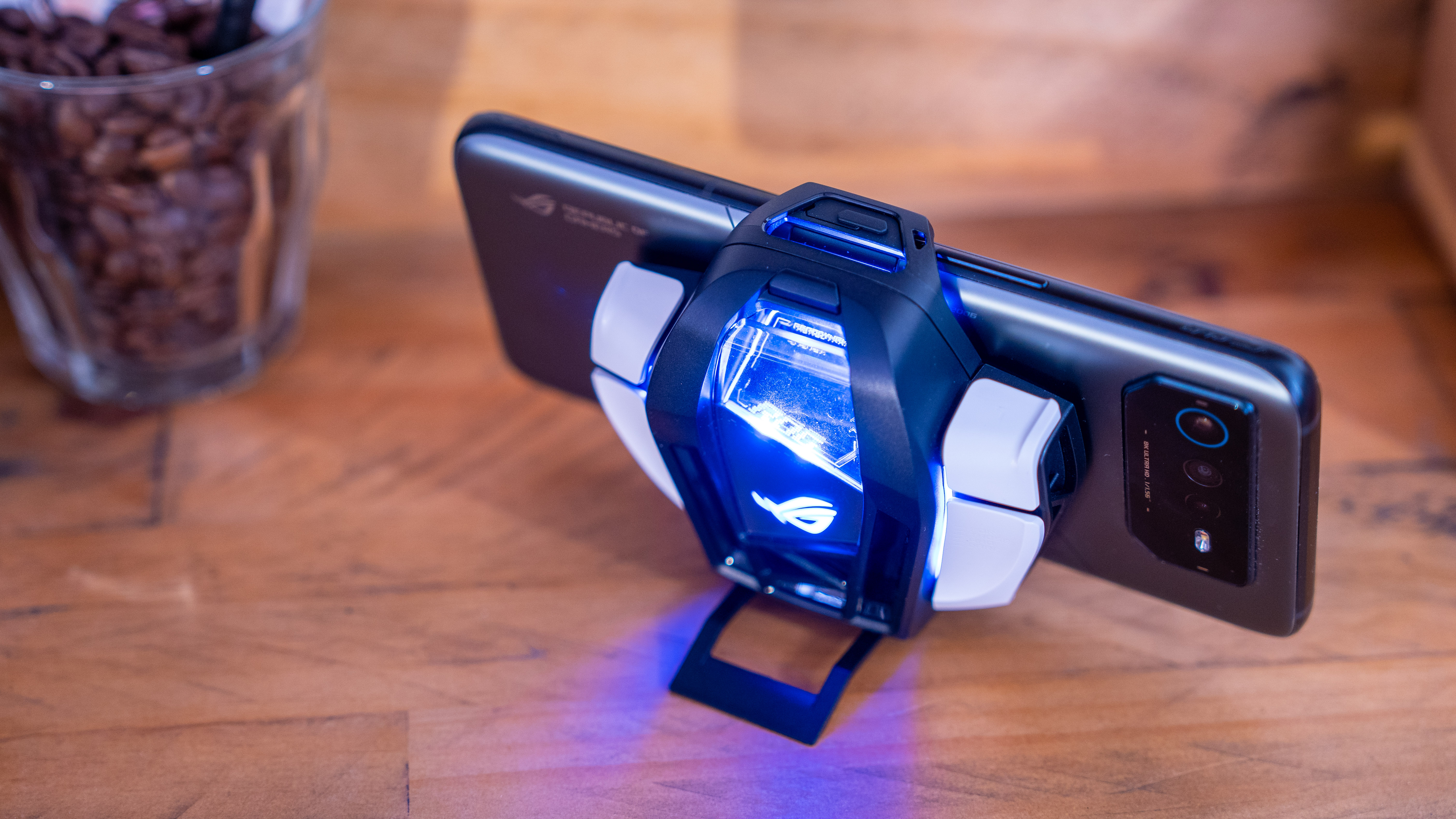
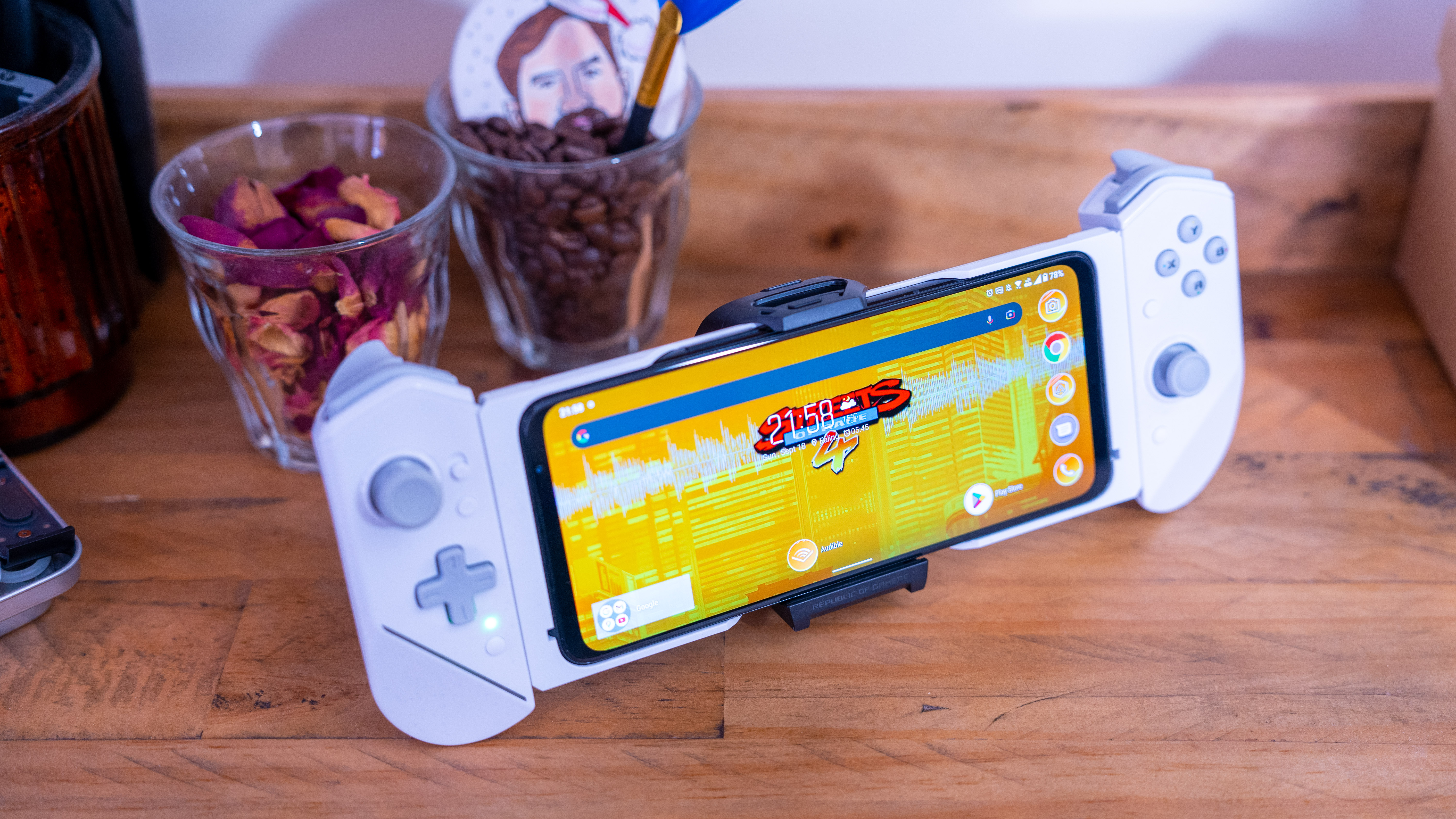
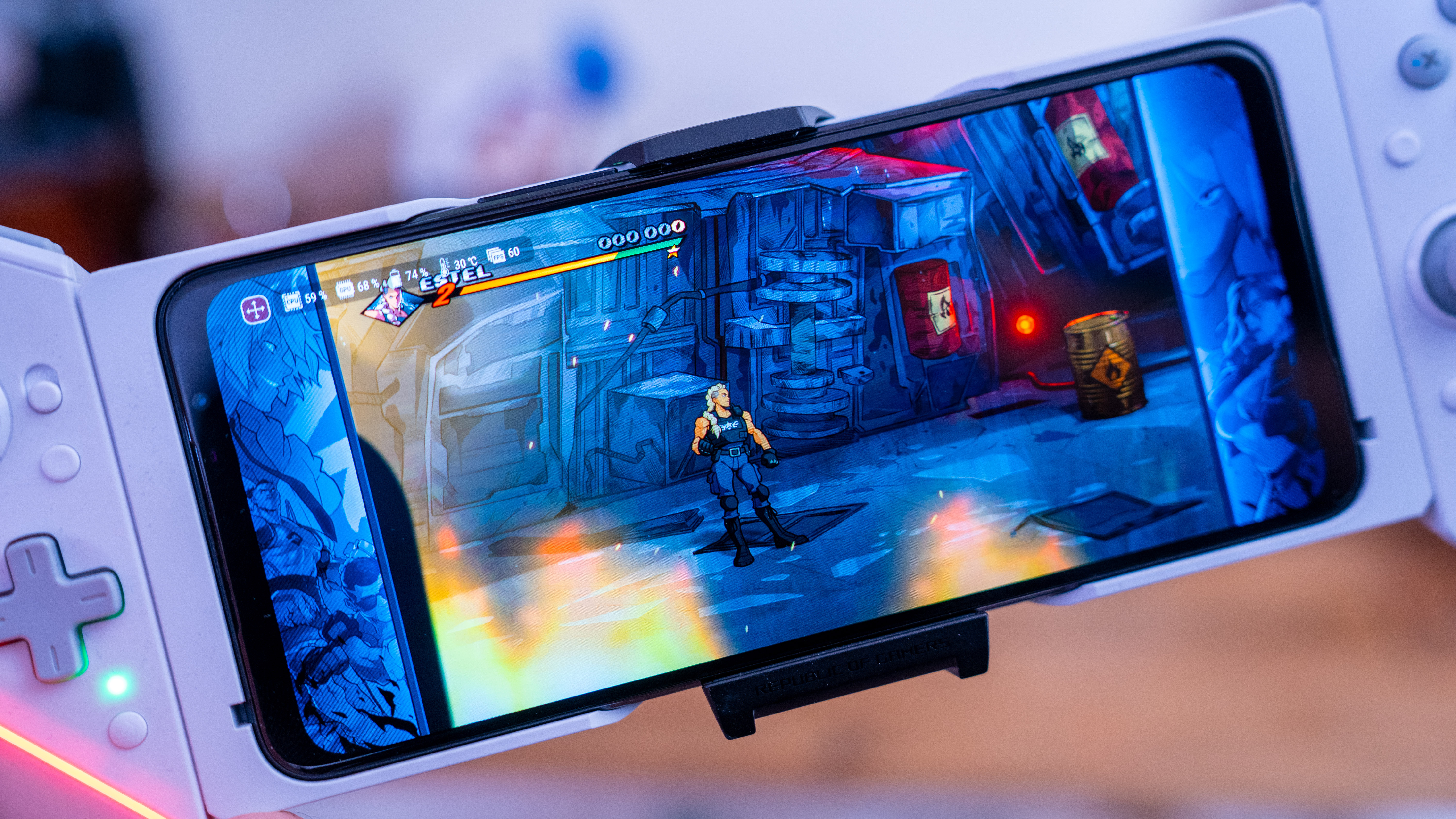
It's worth dwelling on the OLED screen around the back of the ROG Phone 6 and 6D series. This is horizontal on the 6 Pro and 6D Ultimate models, and at an angle on the entry-level models.
More than just a flashy highlight for gamers, Asus adds some utility to the second screen. It can display your notification icons, and battery capacity while charging. The main purpose though is as a visual flourish, and the fact it can mirror the theme you're using on the 6D is excellent. We had our rear screen flashing up with the Streets of Rage 4 logo, and it was over the top in all the right ways.
- Design score: 4/5
Asus ROG Phone 6D Ultimate display
- 6.78-inch wide Full HD AMOLED display
- 2448 x 1080 resolution, 395ppi
- 165Hz refresh rate
The ROG Phone 6D has the same display as the 6, and that's no bad thing. It’s a 6.78-inch Samsung AMOLED screen with a 2448 x 1080 resolution. With a sky-high refresh rate of up to 165Hz, smoothness is in line with the best gaming phones on the block.

The ROG Phone 6D's 2448 x 1080 resolution may seem low for a smartphone that costs as much as it does, but it's on the money for a gaming phone. Most games are displayed in Full HD, and the lower resolution keeps frame rates nice and high. In turn, what you may lose in clarity, you make up for in motion smoothness, whether gaming, swiping through websites, or scrolling through social feeds.
Asus has partnered with Samsung to create an excellent screen-quality experience on the ROG Phone 6D. Its colors are vibrant, perfect for gaming and watching movies on; and manual brightness is great indoors, going super-dark and climbing up to 800nits. In direct sunlight, you'll definitely want to activate high-brightness mode by turning on auto-brightness, and this peaks at 1200nits.
Asus loads up the display settings with plenty of viewing modes, including Natural, Cinematic and Standard– and you can also customize a personal color profile to suit your eyes.
- Display score: 4.5/5
Asus ROG Phone 6D Ultimate cameras
- 50MP camera features a Sony IMX 766 sensor
- 13MP ultra-wide camera
- 5MP macro camera
We had high hopes for the ROG Phone 6 camera when we tested it. After all, its main camera sensor was the same 50MP Sony IMX766 that spearheaded the Oppo Find X5 Pro's photography experience.
We've seen this sensor on a few phones – though it's generally excelled when it's been matched with optical image stabilization (OIS). On the ROG Phone 6 line, however, none of the lenses are optically stabilized.
The phone packs three cameras around the back in total: the main 50MP, f/1.9 camera, an ultra-wide 13MP, f/2.2 camera, and a 5MP f/2 macro camera. Only the main camera packs autofocus, with the ultra-wide focusing from around a meter, and the macro camera focusing at 4cm.

That all isn't to say you can't grab good photos from the ROG Phone 6D. It picks up pleasingly shallow depth when photographing close-up objects, and shots taken in brilliant lighting are, unsurprisingly, rich in detail.
Frustratingly, Asus overprocesses its images in auto mode, so photos are crammed with contrast. That said, it doesn't go to town on noise reduction, so dark areas captured in mixed-lighting environments look grainy when you pinch in.
Many will like the ROG Phone 6D's punchy photos, however, if you really want to get the best from it on special occasions, you'll want to shoot in RAW and edit your pictures manually. It's also worth noting, that with no OIS, handshake creeps in to scupper your shots, so you'll want to keep the phone as steady as possible to give it the best chance of nabbing a great photo.
The phone's night mode is more impressive than its auto mode, interestingly, and it kicks in automatically when the lights drop, whether shooting on the primary or ultra-wide cameras.
The ultra-wide camera shares similar weaknesses to the main camera, but they're a bit more pronounced when night mode isn't fired up. As for the macro camera, this is the weakest camera of the three. Most of the time, we were able to get better macro results by shooting with the main camera and cropping in.
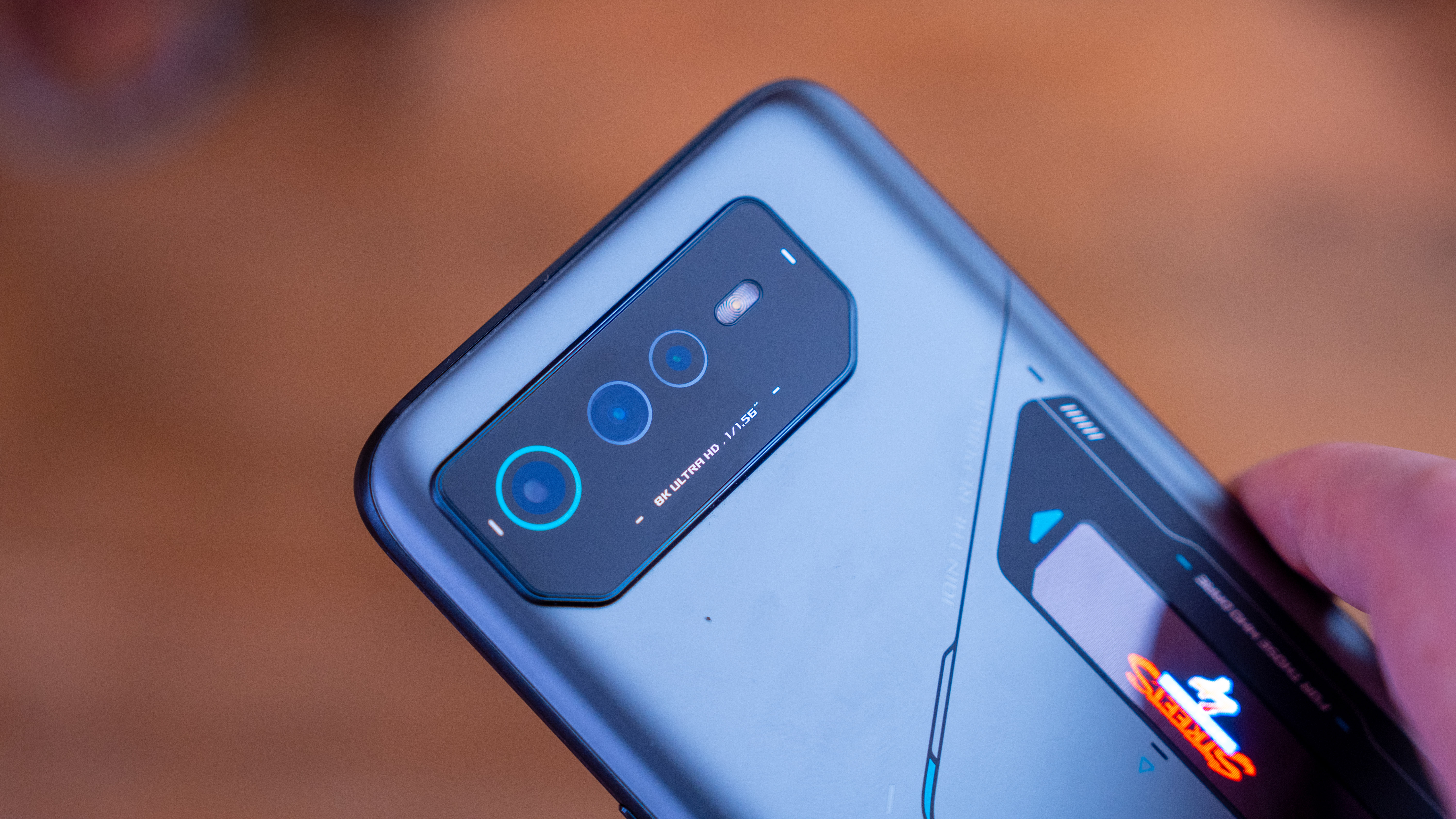
The ROG Phone 6D's 12MP selfie sensor is an IMX663, and its photo and video capture are among the most impressive aspects of the camera mix. While detail from the front camera isn't standout, it does a good job of capturing natural, flattering photos.
Video from the ROG Phone 6D is captured at up to 8K resolution at 30fps, or 4K resolution at up to 120fps. Footage is well stabilized at up to 8K 30fps or 4K 60fps, and looks great in bright environments. Focus is swift too, and enthusiasts can fire up Pro video for more granular control over camera settings.
- Camera score: 3.5/5
Camera samples










Asus ROG Phone 6D Ultimate performance and specs
- MediaTek Dimensity 9000 Plus CPU
- Ultimate Edition: 16GB RAM and 256GB storage
- Runs cool even after an hour of gaming with fan
The Asus ROG Phone 6 introduced Qualcomm's Snapdragon 8 Plus Gen 1, and the ROG Phone 6D introduces the MediaTek Dimensity 9000 Plus: the first flagship processor from MediaTek to feature in a top-tier device in the West.
The MediaTek Dimensity 9000 Plus 5G is produced on a 4nm process, features an CPU clock speed of up to 3.2GHz and a Mali G710 MC10 GPU. It has 16GB RAM and 512GB storage – all top-tier numbers,
As with the ROG Phone 6, Asus has positioned the processor (the heat source) in the middle of the phone for the 6D, which is why the 6D Ultimate's AeroActive Portal is in the center of the phone.
Putting the processor and cooling system in the centre of the phone does a few neat things: it moves the heat further away from your hands, especially when playing in landscape orientation. It also moves it further from two sides of the metal frame (heat conductors) and positions it exactly under the included fan accessory.
We already appreciated how cool the Asus ROG Phone 6 Pro ran, but the 6D Ultimate runs even cooler. Using the AeroActive Cooler fan, we were able to play an hour of Genshin Impact at maximum graphics settings while keeping the temperature below 40 degrees.
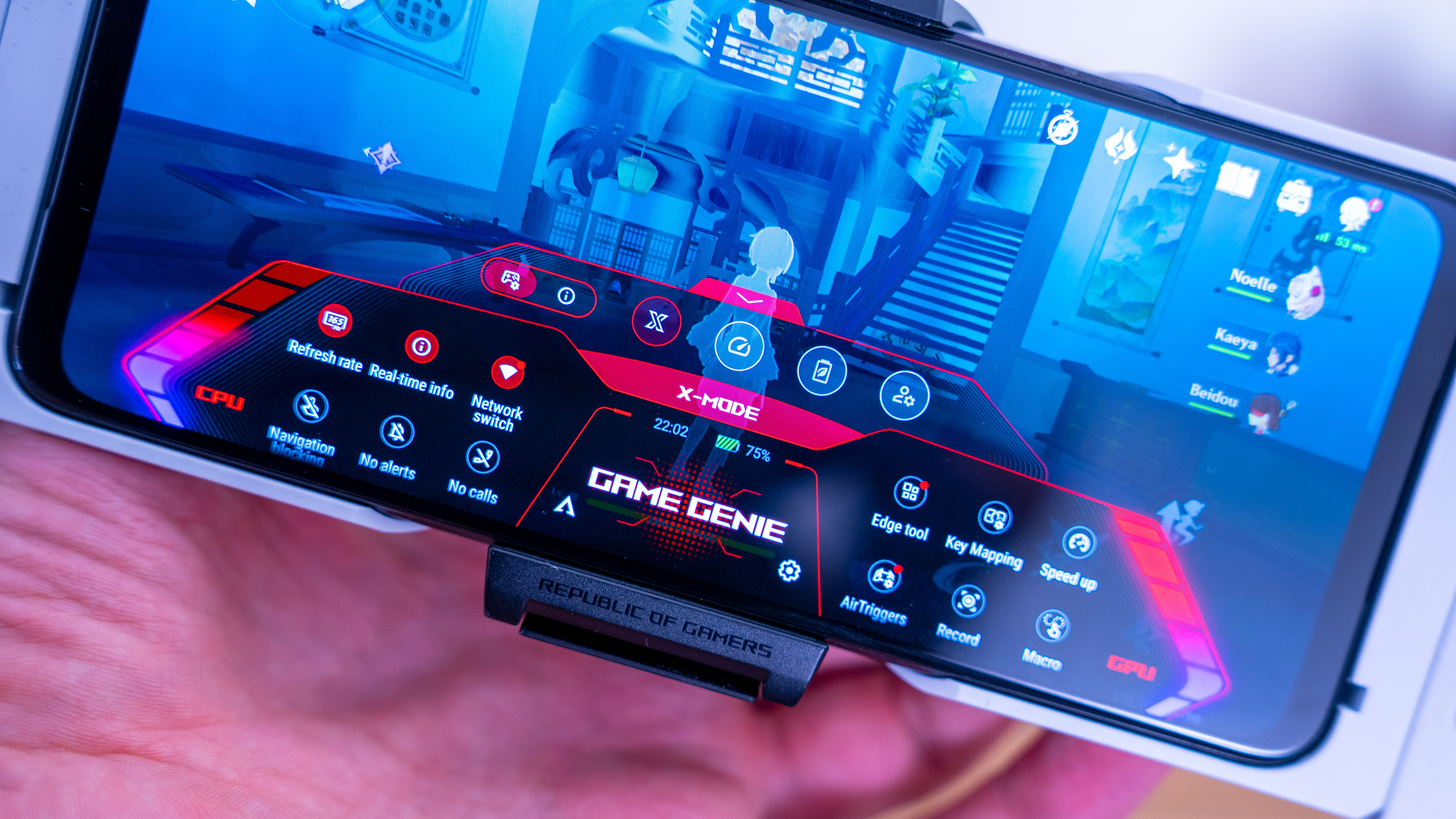
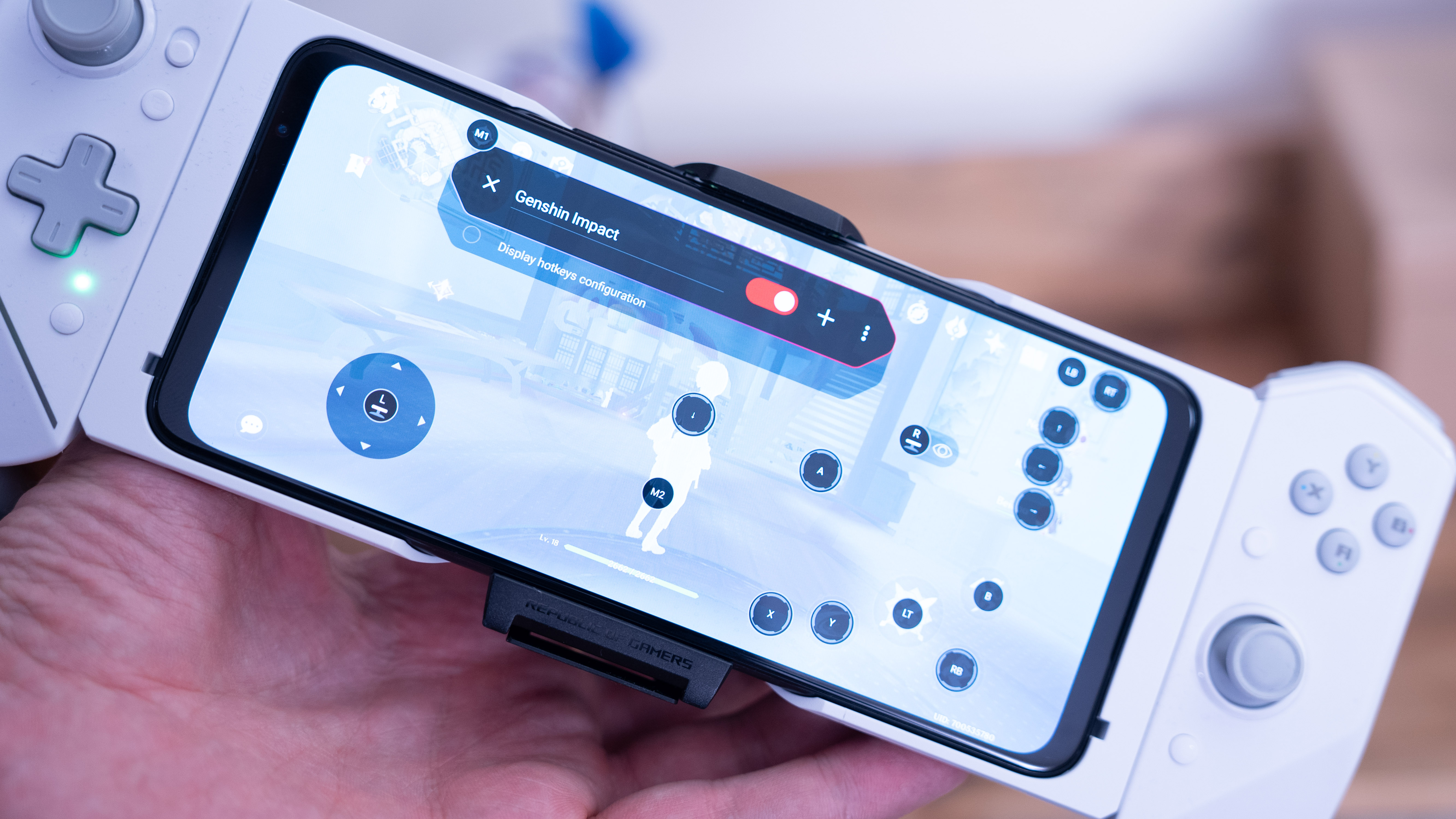
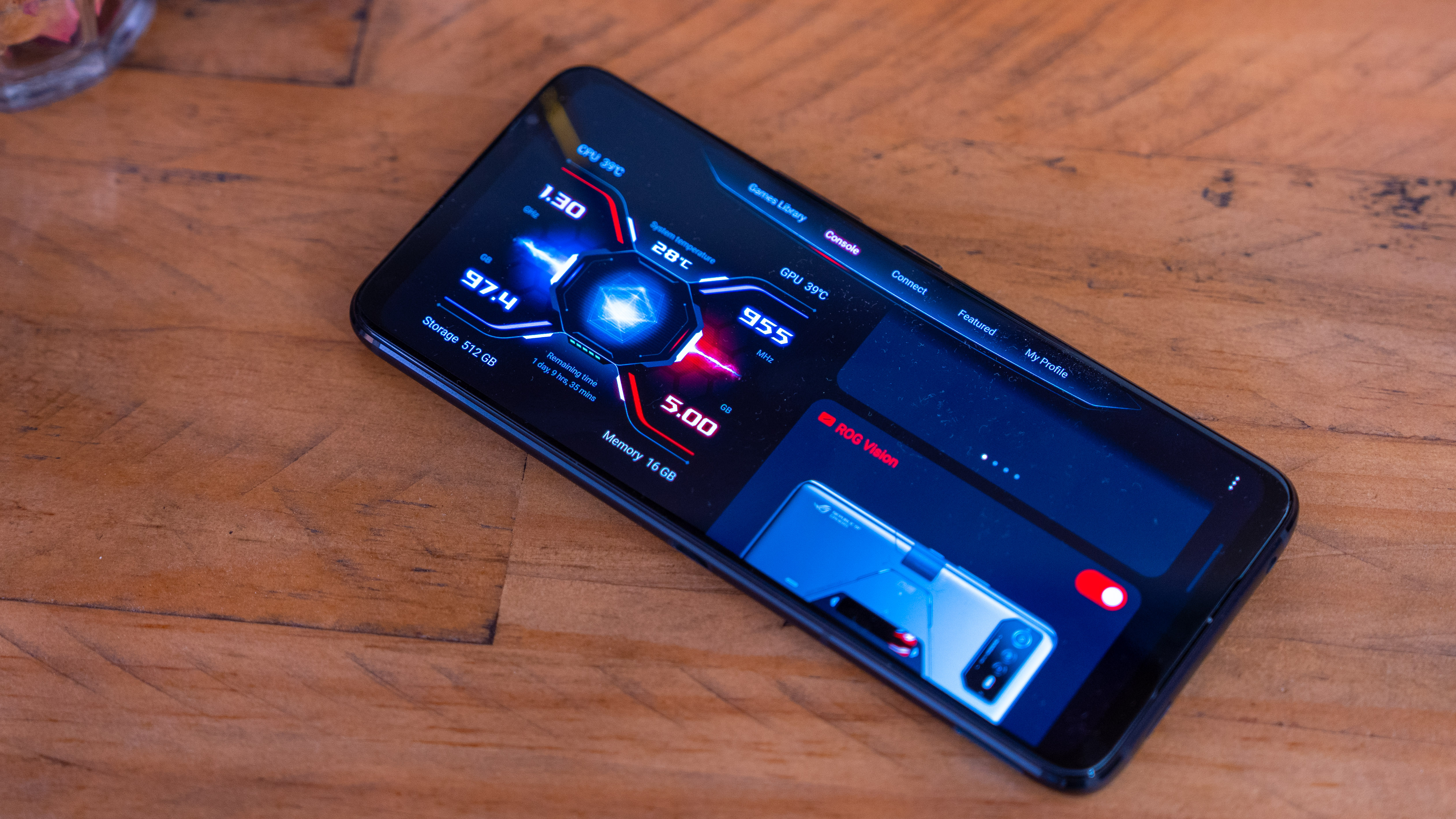

We also gamed with the phone using the Kunai 3 gamepad, which we were easily able to map the buttons on-screen, even for touch titles like Genshin Impact. The AeroActive Cooler also has four shoulder buttons too, making for a really customizable gaming experience.
It isn't just heat that's managed well by the ROG Phone 6D. We were able to stream games super-smoothly using Asus's WiFi and cellular aggregating feature. Where we tested, our 5G speeds actually outperform our WiFi speeds, so using both meant we got excellent results while streaming Nvidia's GeForce Now, or Xbox Game Pass.
- Performance score: 4/5
Asus ROG Phone 6D Ultimate software
- Runs Android 12 with Asus's gamer-centric UI
- Armory Crate aggregates games library and settings
- Game Genie features loads of in-game tools
Asus's ROG Phone 6D Ultimate runs with Android 12, and games and apps are widely available through the Google Play Store.
The whole interface is gaming-themed, and when you squeeze the sides of the phone, the ROG Phone's performance mode – X-Mode – activates; complete with a wallpaper change.
This over-the-top interface won't be for everyone, but for gamers and geeks, the ROG Phone's 6D's UI shines, loaded up with motion wallpapers and lock screens. That being said, if you want to dial things back, you can activate a much more stock mode. This gives you access to all the apps and features you'll need from your gaming phone, but with a much more conservative look and feel.
Put the phone in a traditional case, and when the dialed-back theme is active, you wouldn't be able to tell the ROG Phone 6D is a gaming phone.
It's a shame the phone doesn't support multiple user profiles. With the 512GB inside the Ultimate Edition, there's plenty of room, and it could have been a great tool for a parent or spouse who wants to add extra users while keeping their data private.

The best software enhancements on the ROG Phone 6 series come in the form of Armory Crate and Game Genie. The first, Armory Crate, is where you can find your games, control your official accessories, find new high-refresh-rate titles, and access the ROG community and your own profile.
This is also where you can control the OLED screen around the back of the phone, and open the AeroActive Portal for cleaning.
Game Genie is Asus's in-game software that supports game-specific profiles, be they mapped keys, macros, or setting crosshairs – and that's just scratching the surface.
We used Game Genie to map keys for our various controllers, converting non-controller optimized games, and playing them back on our TV, plugged in via an HDMI adapter.
- Software score: 4.5/5
Asus ROG Phone 6D Ultimate battery life
- Large 6,000mAh battery
- Fast 65W charging
- No wireless charging
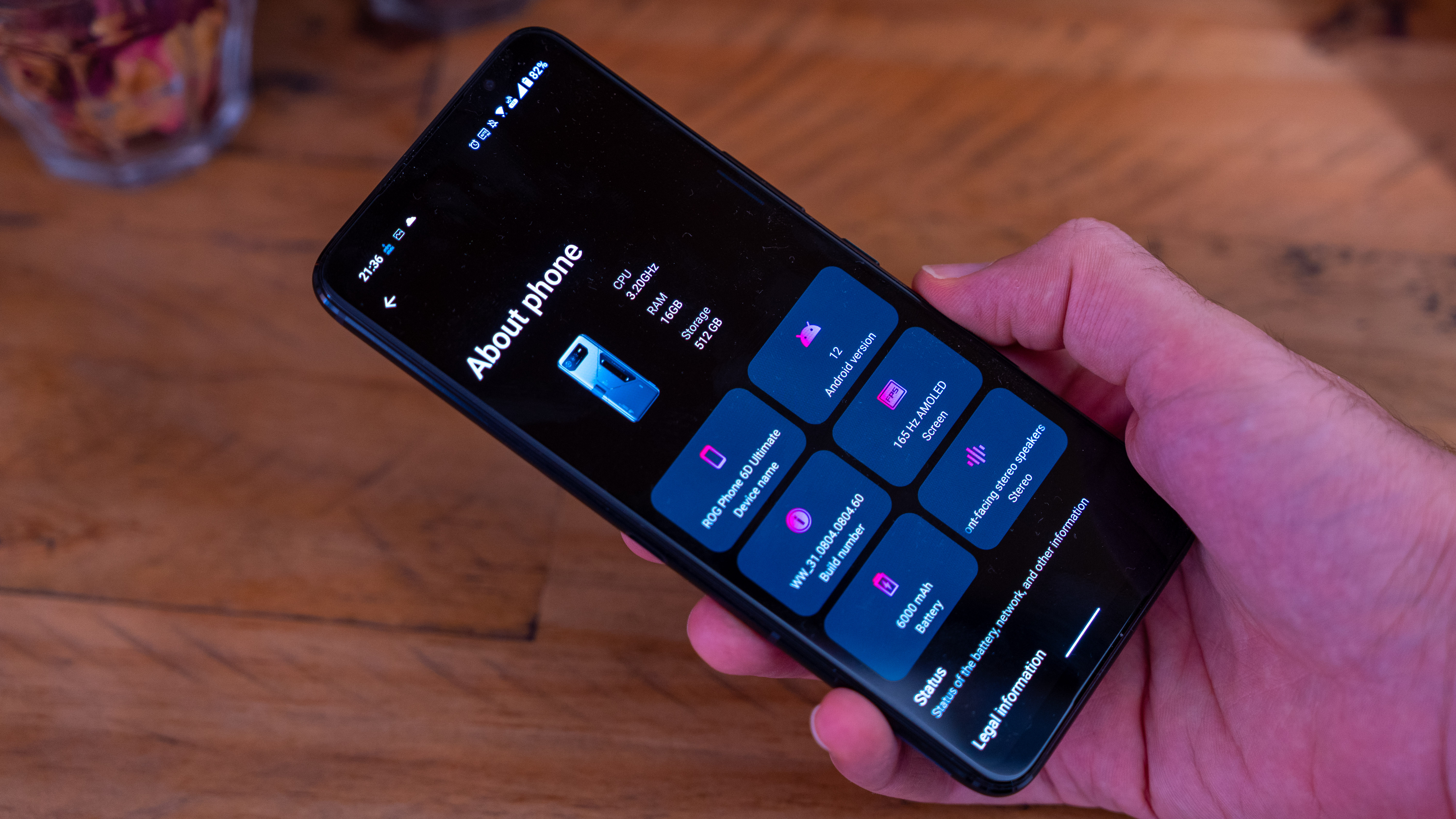
Just like the ROG Phone 5 and ROG Phone 6, the 6D and 6D Ultimate get 6,000mAh batteries, and we couldn't be happier. Unsurprisingly, the phone lasts a full day with regular use, and up to two if you're conservative. But it's when you plug in the accessories that battery life goes way down.
With the fan fired up at maximum power, an hour of gaming drained the battery by over 30 percent. Add the Kunai Gamepad to the mix, and you can expect a couple of hours of gameplay in X Mode when tearing through a demanding title.
Asus has included an optional, bypass-charging mode. This provides power to the system from the charger without actually powering up your battery, thereby reducing battery wear and managing heat just a bit better.
With 65W fast, wired charging, the ROG Phone 6 charges up by 18 percent in 10 minutes, 50 percent in 22 minutes, and 100 percent in under 50 minutes. The phone also ships with a fast charger in the box.
Don't expect wireless charging – the feature hasn't made it into any gaming phone just yet – though we live in hope. If the ROG Phone 6D Ultimate had a better camera and wireless charging, it would be one of the best phones around.
- Battery score: 4/5
Asus ROG Phone 6D Ultimate score card
| Attributes | Notes | Rating |
|---|---|---|
| Design | Love it or hate it, the premium finish and gaming phone highlights make the ROG Phone 6D a standout in its category. | 4/5 |
| Display | While the ROG Phone 6D's screen isn't the sharpest around, it's exactly where it needs to be for a gaming phone, and the image quality and brightness are on point. | 4.5/5 |
| Performance | Asus was the first to market with Qualcomm's latest processor, and it's the first to market with MediaTek's, clearly showcasing its commitment to smartphone gaming. | 5/5 |
| Camera | The ROG Phone's weakest area is its camera, despite improvements over its predecessor. Nevertheless, the main camera still impresses with good looking photos and videos. | 3.5/5 |
| Battery | With a bigger battery than most smartphones and fast charging, it's little wonder the ROG Phone 6D's battery impressed us. The only thing missing is wireless charging. | 5/5 |
| Software | Asus has finetuned its gaming software to near-perfection over the years, and the latest iteration is stellar. We also like the dialled back theme that feels more stock. | 4.5/5 |
| Value | While you can get a better camera phone for less, the ROG Phone 6D is the coolest gaming phone around, and that helps justify its confident price. | 4/5 |
Should I buy the Asus ROG Phone 6D Ultimate?
Buy it if...
You want to game for long periods
Thanks to the new cooling system in the ROG Phone 6D Ultimate, Asus's latest gaming phone games cooler for longer than anything we've tested when hooked up to the AeroActive Cooler fan, which ships with the 6D Ultimate.
You love gadgets
Between the fan, Kunai Controller and the fact you've got a mechanical air vent on the ROG Phone 6D, it feels like a mega-gadget. Build it up with accessories, and it turns into a handheld console. Dial things back and it's a phone again – big gadget energy.
You watch loads of videos
Loud speakers, a great screen and a kickstand in the box (by way of that AeroActive Fan), and your ROG Phone 6D is a portable media player. Unlike many other Android phones, it packs full Netflix HDR 10 support, and with Dirac tuning and customizable sound, it's a sensory sensation.
Don't buy it if...
You like small phones
Asus has you covered if you're on the market for a small phone, but the ROG Phone 6D isn't it. Instead, look to the Asus Zenfone 9, a pocket powerhouse that packs ample power in a much more portable body.
You have a wireless charging pad
If you already own wireless chargers, you won’t be able to use them with this phone, so you might want to consider a different device, or accept a wired charging future.
You want a brilliant camera above all else
If camera quality is your paramount priority, then it might be worth checking out the Galaxy S22 Ultra for zoom, or the iPhone 14 Pro Max, which packs a new, larger sensor.
Also consider...
iPhone 14 Pro Max
With the new A16 Bionic chip matched with the App Store's extensive games library, while the iPhone won't be as adept at running emulators, it is still a world-class gaming phone. Better still, if you pick up the BackBone Edition, you'll be able to get a similar experience to that of the ROG Phone 6D with the Kunai 3 gamepad.
Check out our iPhone 14 Pro Max review
Asus ROG Phone 6 Ultimate
If you can't wait for the 6D Ultimate to launch and won't need its slightly superior cooling system, then the stellar ROG Phone 6 Ultimate is still a smooth operator that delivers a virtually identical user experience and a pearlesque, white luster which we prefer to the 6D's gunmetal finish.
Check out our Asus ROG Phone 6 Ultimate review
Nubia Red Magic 7s Pro
The ROG Phone 6D Ultimate may be excellent, but it's also expensive, so if you're happy dialing back some of the polish, Nubia's Red Magic 7s Pro packs plenty of performance at a much easier-to-digest price.
Check out our Nubia Red Magic 7s Pro review
- First reviewed September 2022

Basil Kronfli is the Head of content at Make Honey and freelance technology journalist. He is an experienced writer and producer and is skilled in video production, and runs the technology YouTube channel TechEdit.
